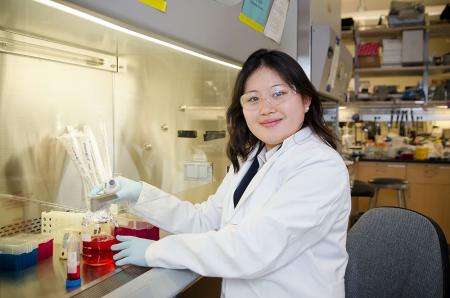Orchestrating the healing process in a damaged cornea

It is safe to say that the eye is an amazing biological system. One reason is its keratocyte cells—specialized cells that make up the bulk of the cornea. Unlike most of the other cells in our body, those in the cornea are transparent, making sight possible. Should something happen to make the cornea opaque, blindness results.
Sadly, injuries to the cornea do occur, sometimes in the simplest of ways, such as getting sand in one's eyes and scratching the cornea. The scar tissue that then grows to heal the cornea may have the unwanted side effect of being opaque. This does not happen, however, if the cornea and the tissue around it heal in a very orderly fashion. The question, then: Is it possible to encourage this orderly healing after an injury, thus preserving vision?
Professor of Chemical Engineering Julia Kornfield and graduate student Amy Fu are very much hoping that this is the case. To find out, they have assigned a few students, including Caltech senior and recent SURF fellow Jacqueline Masehi-Lano, to experiment with various growth factors that might inhibit the formation of scar tissue and promote orderly wound healing.
"We chose three growth factors to test because Amy Fu and I read several papers on growth factors that have been able to suppress some types of scar tissue," Masehi-Lano says. "In particular, we want to inhibit the formation of alpha smooth muscle actin, the type of stress fiber that creates opaque scars over corneal wounds. So far, the experiments I've done with cell cultures have worked pretty well, so it looks promising."
Eventually, the researchers hope to encapsulate the growth factors in a hydrogel that is reminiscent of the native cornea. "Our hydrogel starts out as a liquid and gels in situ on the eye," explains Masehi-Lano.
Masehi-Lano is enthusiastic about her experience with the SURF program. This past summer was her second in Kornfield's lab, and last year she was a recipient of an Amgen scholarship. "I'm really grateful that my mentor and my co-mentor have entrusted me with my own project and have allowed me to conduct my own experiments. And since it was my second summer in this lab, I was able to take up a leadership role by training a new SURF student," she says. "For me, SURF has gone beyond research. I've been able to improve my ability to present my research to the general public, which I think is extremely important." Indeed, Masehi-Lano was awarded the Caltech Doris S. Perpall SURF Speaking Competition for delivering the most outstanding oral research presentation.
Masehi-Lano plans to continue in bioengineering and is contemplating an MD/PhD program. "I've always been interested in the medical field, and though I'm committed to doing research," she explains, "I'd like to be able to do clinical trials and directly apply new medical technologies to people."




















